The second life of payphones
In the CIS, public telephones have practically disappeared from the streets. You can find public telephones at train stations and other public places, but less and less. And abroad they are trying to find a new use. It seemed to me interesting to inform the readers of this article by Daniel Lonescu, who writes a lot about mobile devices, but he didn’t get around this topic.
Payphones seem to be a relic of the past, if you were born in the generation of smartphones. But it is worth adding a few functions, such as a Wi-Fi access point, car charger, taxi-hailing and payphones could easily find a place in our life, starting in New York.
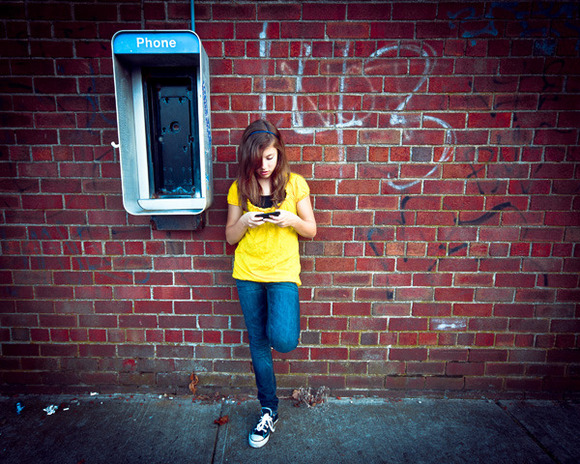
Now in New York there are about 11,000 payphones, which is much less than 35,000 two decades ago. Mayor Michael Bloomberg wants to find a new use for payphones, because most people have mobile phones, and half of them are smart phones.
This is a very large infrastructure that covers the whole city, and the contract of the current network provider expires in 2014. Therefore, three months ago, in December, Bloomberg launched the project “Reinventing a Payphone” (“Reinvent Payphones initiative”) as a public information source of the future.
')
Three months after the Big Apple called on society to share ideas on how to modernize payphones, six finalists were announced. The ideas were evaluated in categories of communication, security, use during an emergency, creativity, functionality, and of course, visual design. There will also be another prize for popularity, which is held by the official Facebook page of Reinvent Payphones - the voting ends on March 14, and you can also leave your vote there.
Of course you can root for any of the finalists and their ideas that may appear on the streets of New York. But according to the WNYC report , all the proposed solutions for the payphone system will be used as reference points, and we will be able to see some of the best ideas (not just the finalists) in the public information point, which will be the former pay phones.
Public telephones in New York proved to be an important link for residents during Hurricane Sandy in October 2012, when electricity was cut off and people were forced to use public telephones to connect with their loved ones. During this period, the biggest problem was the overload of the payphone network in the mode of free calls, the network operator of the editorial staff of Wall Street magazine reported . As a result, payphone software during an emergency situation inspired developers with several useful innovations.
Lighthouse (Beacon)
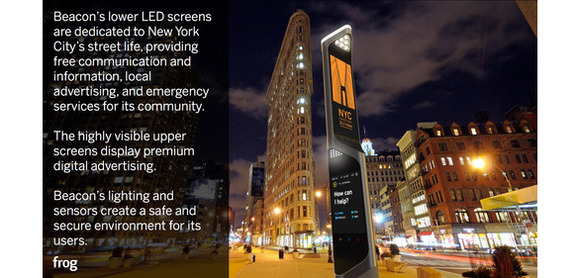
Lighthouse is the winner in the category "Best Visual Design." It is a sporty and slim design made of concrete and stainless steel, almost 12 feet high. It contains a set of LED screens, and the top of the display matrix works as a public information digital board that can display urgent and simple public announcements throughout the city.
During a state of emergency, the lighthouse could become an information kiosk, displaying vital information, instructions for evacuating and reporting addresses of shelter points and assistance.
Windchimes (Windchimes)
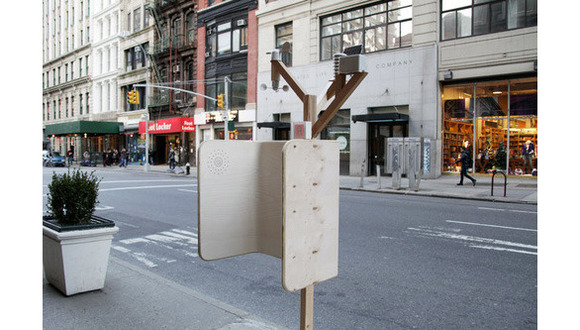
Bells won the “communication with community” nomination, and looks a little less futuristic than other projects. However, this prototype includes a number of environmental sensors for rain levels and environmental pollution that will assist authorities and city planners in assessing air quality in New York.
Smart Sidewalks
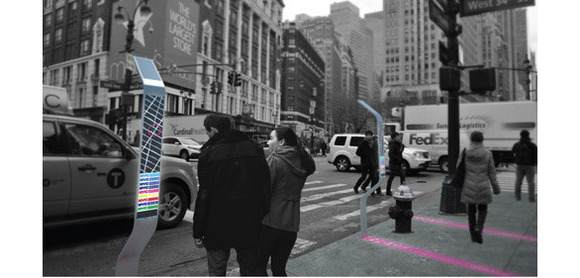
Smart sidewalks, the winner in the "functionality" category, are going to reduce the area occupied by payphones, while offering a free Wi-Fi access point, providing weather information, and offering navigation maps and information for pedestrians.
Nyfi
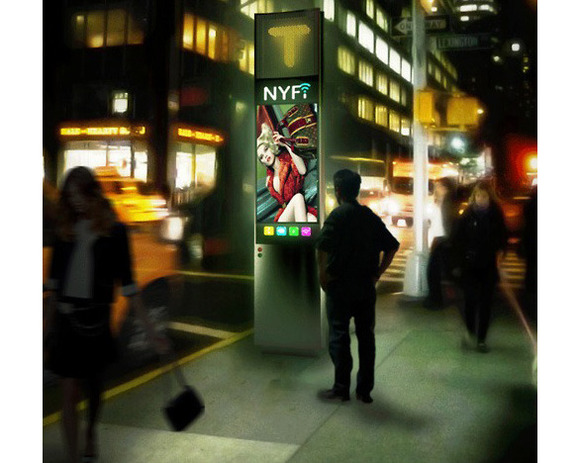
NyFi winner in the category "communication". The idea involves an interactive public information portal with an application-like interface and a free Wi-Fi hotspot. In reality, NyFi offers two models - a 10-foot version for business areas and a smaller one for residential areas and historic areas. When not in use, the touch screen will display ads and announcements.
NYC I / O
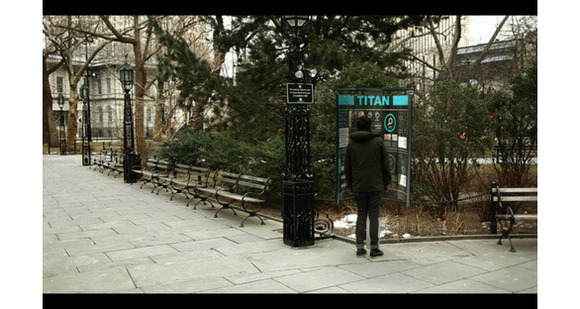
The winner of the “impact on the community” category offers to equip the exterior of the cabin with commercial and social advertising, while information for navigation and other useful public information will be available inside. Normal calls and taxi calls will also be available.
NYC Loop
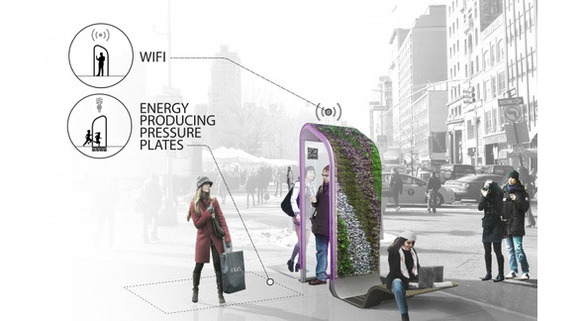
The winner in the category "creativity." The payphone is equipped with a public charger based on piezoelectric plates that convert kinetic energy into electrical energy and charges mobile devices. Depending on the area, it may include the installation of benches, bicycle racks, a charger for electric vehicles and a place for street performers or street art (graffiti, etc).
Daniel Lonescu
Payphones seem to be a relic of the past, if you were born in the generation of smartphones. But it is worth adding a few functions, such as a Wi-Fi access point, car charger, taxi-hailing and payphones could easily find a place in our life, starting in New York.

Now in New York there are about 11,000 payphones, which is much less than 35,000 two decades ago. Mayor Michael Bloomberg wants to find a new use for payphones, because most people have mobile phones, and half of them are smart phones.
This is a very large infrastructure that covers the whole city, and the contract of the current network provider expires in 2014. Therefore, three months ago, in December, Bloomberg launched the project “Reinventing a Payphone” (“Reinvent Payphones initiative”) as a public information source of the future.
')
Three months after the Big Apple called on society to share ideas on how to modernize payphones, six finalists were announced. The ideas were evaluated in categories of communication, security, use during an emergency, creativity, functionality, and of course, visual design. There will also be another prize for popularity, which is held by the official Facebook page of Reinvent Payphones - the voting ends on March 14, and you can also leave your vote there.
Of course you can root for any of the finalists and their ideas that may appear on the streets of New York. But according to the WNYC report , all the proposed solutions for the payphone system will be used as reference points, and we will be able to see some of the best ideas (not just the finalists) in the public information point, which will be the former pay phones.
Public telephones in New York proved to be an important link for residents during Hurricane Sandy in October 2012, when electricity was cut off and people were forced to use public telephones to connect with their loved ones. During this period, the biggest problem was the overload of the payphone network in the mode of free calls, the network operator of the editorial staff of Wall Street magazine reported . As a result, payphone software during an emergency situation inspired developers with several useful innovations.
Lighthouse (Beacon)

Lighthouse is the winner in the category "Best Visual Design." It is a sporty and slim design made of concrete and stainless steel, almost 12 feet high. It contains a set of LED screens, and the top of the display matrix works as a public information digital board that can display urgent and simple public announcements throughout the city.
During a state of emergency, the lighthouse could become an information kiosk, displaying vital information, instructions for evacuating and reporting addresses of shelter points and assistance.
Windchimes (Windchimes)

Bells won the “communication with community” nomination, and looks a little less futuristic than other projects. However, this prototype includes a number of environmental sensors for rain levels and environmental pollution that will assist authorities and city planners in assessing air quality in New York.
Smart Sidewalks

Smart sidewalks, the winner in the "functionality" category, are going to reduce the area occupied by payphones, while offering a free Wi-Fi access point, providing weather information, and offering navigation maps and information for pedestrians.
Nyfi

NyFi winner in the category "communication". The idea involves an interactive public information portal with an application-like interface and a free Wi-Fi hotspot. In reality, NyFi offers two models - a 10-foot version for business areas and a smaller one for residential areas and historic areas. When not in use, the touch screen will display ads and announcements.
NYC I / O

The winner of the “impact on the community” category offers to equip the exterior of the cabin with commercial and social advertising, while information for navigation and other useful public information will be available inside. Normal calls and taxi calls will also be available.
NYC Loop

The winner in the category "creativity." The payphone is equipped with a public charger based on piezoelectric plates that convert kinetic energy into electrical energy and charges mobile devices. Depending on the area, it may include the installation of benches, bicycle racks, a charger for electric vehicles and a place for street performers or street art (graffiti, etc).
Daniel Lonescu
Source: https://habr.com/ru/post/176937/
All Articles